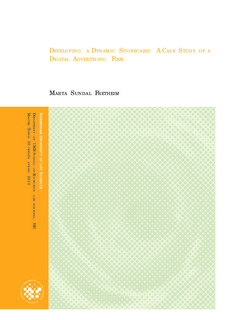| dc.description.abstract | The scope of
this
research
is
to
develop
an
instrument
for
the
evaluation
and
improvement
of
organizational
performance
for
a
digital
advertising
firm.
A
review
of
the
most
common
management
instruments
was
conducted.
The
balanced
scorecard,
developed
by
Robert
Kaplan
and
David
Norton
in
1992,
was
chosen
for
further
development.
However,
limitations
have
occurred
since
then,
and
most
of
them
are
related
to
the
actual
dynamics
of
the
model.
Combining
the
balanced
scorecard
and
system
dynamics
methodologies
therefore
seemed
like
a
good
solution
in
overcoming
the
associated
model
limitations.
By
the
use
of
system
dynamics,
a
conceptual
model
was
developed
and
structured
in
accordance
to
the
perspectives
in
the
balanced
scorecard.
To
gather
necessary
information,
all
processes
involved
in
the
production
of
digital
advertising
were
mapped
through
interviews
and
internal
documents.
The
conceptual
model
was
meant
to
give
a
better
understanding
of
the
dynamics
and
complexity
of
the
organization
and
support
strategic
decision-‐making.
The
developed
model
is
representing
a
virtual
world
developed
on
the
basis
of
the
conceptual
frameworks
of
the
organization.
It
therefore
enables
testing
and
analysis
of
future
performance
and
applicable
strategies.
The
test
runs
were
used
to
develop
a
Dynamic
Balanced
Scorecard
strategy
map,
explaining
the
objectives
and
indicators
of
the
organization.
It
is
important
to
note
that
the
model
entails
simplifications
of
the
actual
organization
and
the
real
world;
it
is
only
focusing
on
key
variables
that,
to
some
extent,
have
been
based
on
assumptions.
The
resulting
model
has
not
yet
been
tested
in
the
real
world,
the
actual
effect
is
therefore
somewhat
uncertain.
However,
the
model
supplies
management
with
a
better
understanding
of
the
complex
relationships
between
organizational
activities
and
performance,
making
it
easier
to
analyze
strategic
decisions
as
well
as
determining
the
strategic
direction.
The
virtual
world
can
improve
the
learning
efficacy
and
thereby
reduce
expensive
erroneous
decisions. | no_NO |
